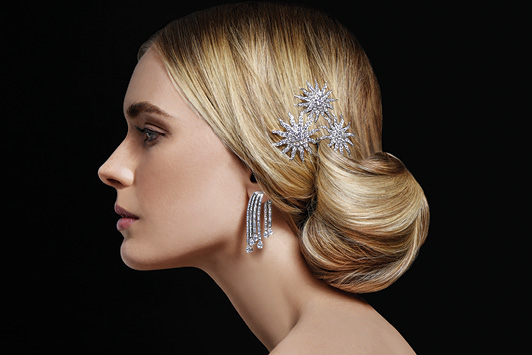
The sparkling brooches of our grandmothers’ jewelry boxes have gone on to make a power statement on the shoulders of modern monarchs and politicos, and now this personal ornament is piquing the imagination of a younger generation.
Blame it on the boys: The flamboyant performers who have been strutting down the red carpet with elaborate jewels pinned to their tuxedos have started something. Actors Chadwick Boseman, Billy Porter and Henry Golding are among the men who have helped reignite a buzz around the brooch.
It’s a big leap forward for an item that was once a strictly functional part of a wardrobe. “Brooches began their life as garment fasteners, and their use has risen or fallen as changes in fashion have made them more or less wearable,” observes Rachel Church, author of the book Brooches and Badges. Although the button made their role as fasteners redundant, the evergreen popularity of shawls and wraps kept the call for decorative pins alive among commoners when only the nobility was bearing brooches as insignia.
A 17th-century passion for bling brought jewels into the equation; large gold pins dripping diamonds and sometimes punctuated with rubies became all the rage in Europe, from Prague to Paris. This was the era of the earliest diamond bows, a design that has endured into modern times. The 17th century also made brooches acceptable for men, whose jewelry had hitherto been limited to signet rings, watches and chains. But when World War I decimated the male population at the start of the 20th century, and the subsequent Wall Street crash diminished the drive to dress up, the brooch once again became exclusively the province of women.
Back in fashion
While prominent public figures — including former US Secretary of State Madeleine Albright and former UK Supreme Court chair Baroness Hale — kept giant statement brooches in the news, it’s the fashion world that has brought the brooch back to center stage.
Vogue magazine heralded the comeback as a major trend for Spring/Summer 2020, citing outsize Gucci butterflies, Versace bows, and elaborate pins by up-and-coming design stars Martin Margiela, Erdem, and Dries van Noten.
Louis Vuitton models even danced corsages down the catwalk last year, while Chanel said it with flowers of the kind Coco herself favored — the camellia, which inspired the brand’s 1.5 collection last year. The 50-piece line featured diamonds, pink sapphires, rubies and rose gold. Why the camellia? “She preferred its sobriety, its almost geometric roundness and the classic ordering of its petals in perfect symmetry to the opulence of a rose,” according to the house. Indeed, in a reversal of emulating the flower in diamonds, Chanel herself chose to wear an actual camellia “like a jewel, in stark contrast against a little black dress or sweater.” The house also showed brooches in its 2019 Le Paris Russe de Chanel collection.
Fred Leighton, famous for its breathtaking collection of high-end vintage jewelry, has dressed both Prada models on the catwalk and Sarah Jessica Parker for a Gap campaign, showing that brooches can set off anything from sportswear to ball gowns. “If not pinned to a jacket, it can be worn at the waist or fastened into the hair,” says chief creative officer Rebecca Selva. “And let’s not forget how many vintage necklaces and tiaras are designed with detachable pieces which can be broken out to wear as brooches.”
Not just for lapels
The difference today is the move toward more creative ways to wear them, Selva says: “Brooches are not nearly as formal as one might think; they can also convey whimsy.”
Actress Michelle Williams attracted attention at the 2012 Oscars with a vintage diamond bow pinned to the waist of her ball gown, while Allison Williams had a diamond brooch pinned to the neck of her own at the 2015 Met Gala.
Kristen Holton, founder of HK Fine Estate Jewels, has made brooches eye-catching in even more unexpected places. “We have been restringing pearls in a way where you can use a variety of brooches as the closure,” she explains. “My favorite way to use a brooch is as a clasp for a necklace.”
Modern US brooch designs pay homage to the evergreen lapel ornaments of old: a butterfly with an assortment of rough diamonds and rubies by Michael M, and more elaborate creations from Graff — including a sapphire and diamond bird on a diamond branch, and a diamond frog entwined with yellow gold.
In the UK, Theo Fennell, who regularly dresses the lapels of pop legend Elton John, is striking out with bolder pieces. While the diamond-winged bee brooches the singer sported at last year’s
Rocketman premiere were inspired by one of the first pieces Fennell ever helped make — an item for a Czech designer he was working with at the time — he is often less literal in his designs. “I have always thought of brooches as pieces that allow for real flights of fantasy,” says Fennell. “They don’t have to fit anyone, so they can be designed with recklessness.”
One reckless piece, in both its ambition and its $60,000 price tag, is Fennell’s artistically astonishing diamond, emerald, ruby and sapphire-studded portrait of Henry VIII. Unlike his skull brooches depicting other iconic monarchs such as Cleopatra, Elizabeth I and Henry V, this one features a full-featured face carved from bone.
Fennell sees a bright new future for brooches, with designers combing the imagination for bold subjects rather than merely aping the classic insect and bow imagery of old. “Now that men are also wearing them, they have taken on a new life as a genuine, wearable work of art,” he declares.
Image: Fred LeightonArticle from the Rapaport Magazine - March 2020. To subscribe click here.